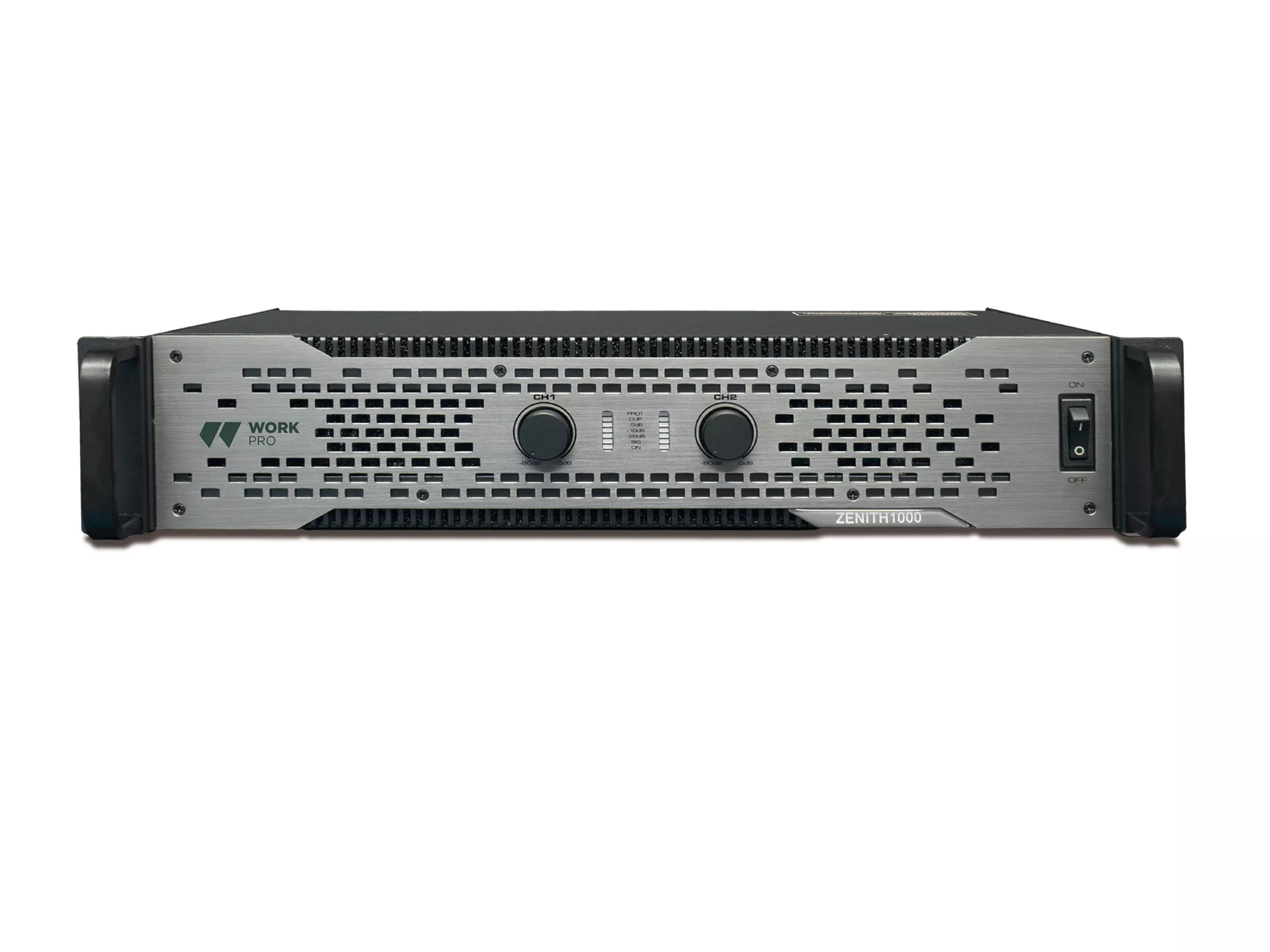ZENITH 1000
51ZEN100
Audio amplifier
Zenith 1000 is a 500W @ 4 Ohm 2-channel professional audio amplifier, with switching power supply, built in a 2-rack-unit metal enclosure. It has balanced inputs in XLR3 format and outputs with XLN4 connectors. It has selectors for input sensitivity and operating mode. It also has protection systems against short circuit, temperature, DC, VHF and constant high frequency signal. The front panel has a power switch, independent volume controls for each channel, and power, signal, clip and protection indicators.
Features
- Stereo / Bridge / Parallel modes.
- Volume control and level meter.
- Signal, clip and protection indicator LEDs.
- 2 19-inch rack units.
| Type | Class D. Switching source |
| No. Channels | 2 |
| W/Ch @ 8 Ohm | 300 W |
| W/Ch @ 4 Ohm | 500 W |
| W Bridge @ 8 Ohm | 1000 W |
| Frequency Range | 20 Hz - 20 KHz |
| THD+N | <0.15 % |
| S/N Rate | >100 dB |
| Damping Factor | >500 |
| Gain | 36 dB |
| Input Impedance | 20 KOhm (balanced) / 10 KOhm (unbalanced) |
| Input Sensitivity | 0.775 V / 1 V / 32 dB |
| Connections | Power: Powercon; Signal: XLR3 for input and output; AMP: NL4 |
| Protections | Soft start, VHF, DC, Overload, Clip, Limiting, Short-circuit, Over-temperature, Progressive volume |
| Refrigeration | Fans Air flow from front to rear |
| Power supply | AC 100-240 V, 50/60 Hz |
| Consumption | 480 W |
| Dimensions | 483 x 88 x 305.5 mm |
| Weight | 7.3 Kg |
| Length(m) | Width(m) | Height(m) | Weight(kg) | |
|---|---|---|---|---|
| Product | 0.31 | 0.48 | 0.09 | 7.30 |
| Box | 0.42 | 0.55 | 0.16 | 7.20 |
Votes
QUESTIONS
The Zenith series amplifiers have been designed to operate at 4 and 8 Ohms in Stereo and 8 Ohms in Bridge mode, so no impedance lower than those indicated should be used.
Stereo mode: In this mode, the amplifier has two independent channels, usually labelled left channel (L) and right channel (R). Each channel feeds one speaker or a set of speakers. It is used to play stereo music, where there are different signals for the left and right channels, providing a surround sound experience. Bridge Mode (Bridged Mono): In Bridge mode, the amplifier combines the two channels into one. The positive terminal of one channel is connected to the negative terminal of the other channel, creating a single amplified channel. It is used when higher power is needed for a single loudspeaker, such as in situations where power is required for a subwoofer or for power output to a HiZ 70/100V line. Parallel Mono Mode: In this mode, both amplifier channels are used to power the same loudspeaker or set of loudspeakers. The channels share the load in parallel. It is used to increase the power available to a single speaker without increasing the total impedance.
- 0.775V is the maximum input level that the amplifier will accept for optimum performance; it represents the RMS voltage with a 1V peak signal, this signal is the usual signal of unbalanced domestic equipment, so the amplification will be higher. - 1 V is the level representing a value of 0dbV, which is the balanced signal used in the outputs of musical instruments, this sensitivity may not be optimal for professional equipment with a balanced output of +4dbu. - 32 db is the logarithmic way of expressing a linear amplification of a balanced line signal and is recommended for professional equipment with +4dbu output.
 Next Login
Next Login











